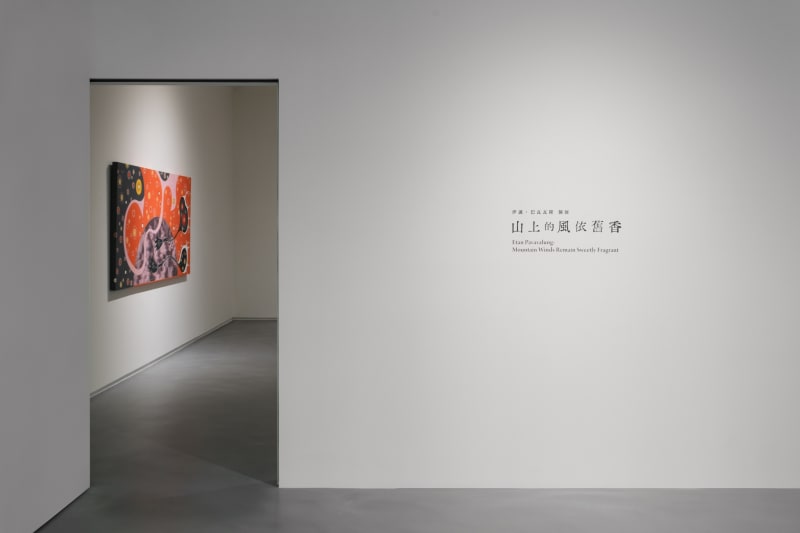“This is the longest course, returning to where we started.” ––Parangalan (De-Fu HU), ‘The Longest Course’
Etan Pavavalung’s solo exhibition Mountain Winds Remain Sweetly Fragrant at Asia Art Center (Taipei) from September 14 to November 10, 2024, continues the concept from his solo show The Fragrant Mountain Winds at the Taipei Fine Arts Museum (TFAM) in 2014. That exhibition was Etan’s first solo exhibition after Typhoon Morakot, and was also the first large-scale and coherent solo exhibition in his artistic career.
After a decade, the solo exhibition Mountain Winds Remain Sweetly Fragrant uses “winds” and “spiritual birds” as metaphors to represent Etan’s aesthetic worldview. In Etan’s aesthetic, spiritual birds symbolize a kind of eternal existence. Even as time brings irresistible change, vitality, and decline to all things, spiritual birds still guide us a path and ensure that the winds from the mountains remain fragrant, just as they have always been.
Typhoon Morakot in 2009 severely destroyed the Paridrayan tribe where Etan lived, and the resettlement after the disaster also caused him to reflect the bond between humans and the natural environment. For Etan, Typhoon Morakot impacted him deeply; even though he had long utilized his art to advocate for indigenous rights, the typhoon damage leading him to embrace art as a means of spiritual rebuilding—not only for his original Paridrayan tribe but also to maintain spiritual belonging after the disaster. After Morakot, Etan and his community relocated to the Rinari Permanent Housing Community, which combining three tribes from different groups of Paridrayan, Makazayazaya and Kucapungane. Although they now lived in “permanent” housings, many, including Etan, still longed to return to their original homes in the mountains. “Water from the tribal homeland, tasty so very! Along the creek as the wind picks up, how fragrant it is!” Inspired by an elder’s ancient chant that recalled the fragrance of the wind on the mountain, Etan used his unique “Trace Layer Carve Paint” technique to transform traditional Paiwan patterns into a contemporary visual and narrative system. This process, akin to the accumulation of ancient language and cultural education, Tjasiumalj tjasiumalj (means repetition after repetition), allows Etan to communicate with the past while bringing those ideas into the contemporary.
Since Etan’s 2014 solo exhibition at TFAM, “winds” have consistently been a fundamental element in Etan Pavavalung’s art. Winds are like messengers, bringing hope, sustaining life and soothing pain. The path guided by the spiritual bird is also hidden within the wind. Like the scent brought by the wind in the ancient chant, the meticulous wind patterns connect each narrative in his works, intricately linked and inseparable. Inspired by that ancient chant, Etan wrote a poem capturing the essence of the wind’s message:
These sights, these events
They are engraved into a typhoon-ravaged land
I want to head up the mountains
Letting my heart follow the wind
Chasing the musical notes in my souls
Notes that compose the odes of the creeks
I want to be cloaked once more
By the colorful singing winds
Lingering in my dreams
The ever-fragrant winds of the mountains.
The exhibition title Mountain Winds Remain Sweetly Fragrant echoes Etan’s poem and serves as a response to the elder’s reminder, reflecting his desire for spiritual reconstruction over the past decade. Through this exhibition, Etan not only reconstructs the spiritual and cultural path in his heart but also maintains a connection to his homeland through art and action.
This exhibition spans nearly a decade of Etan’s artistic thoughts, guided by the dual concepts of “winds” and “spiritual birds,” leading viewers to search their own sacred mountains. The works on display include his most well-known “Trace Layer Carve Paint” pieces, newly created mixed media works and slate carvings, as well as several pieces that were part of the 10th Asia Pacific Triennial of Contemporary Art in Australia in 2021. And a remarkable large-scale work Flyng, created in 2017, which has toured internationally. This piece, with its clear and concise composition, depicts a spiritual bird flying in the wind, reflecting the primary imagery in Etan’s artistic journey and is a hallmark of his “Trace Layer Carve Paint” aesthetic. The word “Remain” in the exhibition title not only reflects Etan Pavavalung’s artistic origins but also symbolizes that the tribe in the mountain that once blew the fragrant wind is no longer an unreachable place. Thought time flied, Etan seeks to convey through this exhibition that the mountain winds remain sweetly fragrant.


